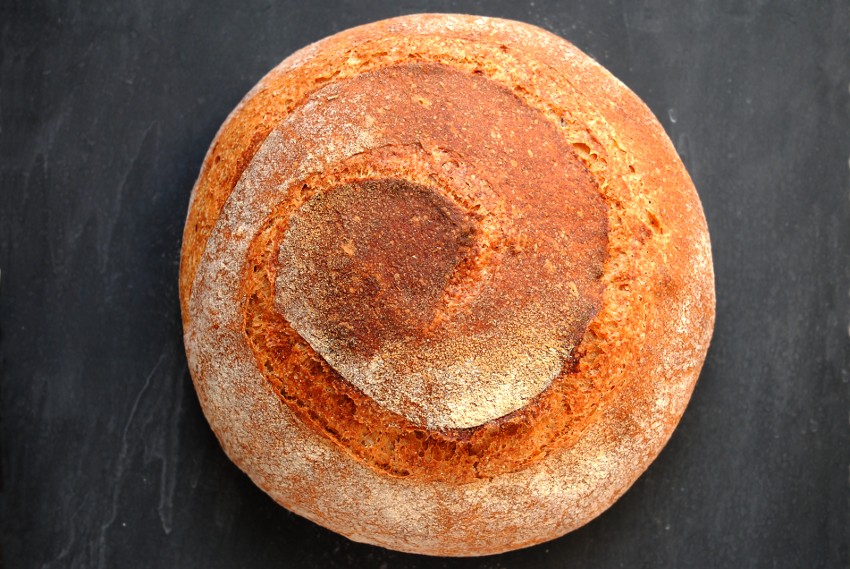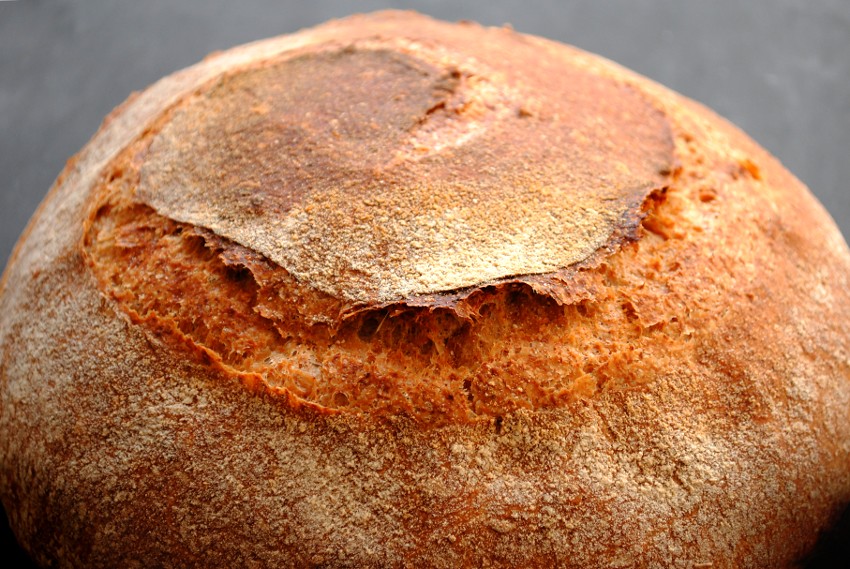A Special Baking loaf
In my last post I talked about Sekowa ‘Special Baking Ferment’ and how to prepare a starter with it. Once the starter is established it can be stored in the fridge until required, and doesn’t need to be revived as a refrigerated sourdough starter does. But how do you actually make bread with it?
The instructions that come with the ferment include a recipe for a mixed strong white/wholemeal flour loaf. While straightforward enough, the quantities involved are rather large – the recipe requires nearly 2kg of flour! I reduced the quantities and experimented with several different formulae before finding one that worked pretty well for me.
The first step is to prepare a sponge. This includes some of the starter you’ve prepared and a small quantity of the Sekowa granules themselves.
15g Special Baking Ferment starter
5g Special Baking Ferment granules
150g water at about 30°c
150g strong white flour
In a bowl, add the starter and the granules to the warm water and whisk until dissolved. Then add the flour and mix thoroughly. Leave, covered with a tea towel or clingfilm, in a warm place overnight or for about 12 hours. It does seem like the Sekowa ferment needs warmer temperatures than usual, about 25°c upwards. At lower temperatures I found it took much longer to start fermenting. This applies to the starter, sponge and the bread dough itself.
After this time the batter should be full of bubbles. Now add the remaining ingredients to the sponge.
200g water
150g strong white flour
200g strong wholemeal flour
5g salt
Knead the dough for about 5 minutes. The dough will be soft and sticky, but it will become a bit easier to manage with kneading. Leave the dough to rise in a clean bowl in a warm place. This will probably take about 2-3 hours, perhaps more depending on the temperature. Now shape the dough and leave it in a tin or proving basket to prove. This shouldn’t take as long – about 1½-2 hours. By this time it should have approximately doubled in size. Bake in an oven pre-heated to 220°c for 40-50 minutes.
This gave me a loaf with a nice open crumb and a chewy crust. There was no pronounced sourdough flavour, which could be a plus or a minus depending on your preference. One thing I did notice was that the doughs I made with the Sekowa ferment were noticeably softer and stickier, relative to the amount of water in them, than I would have expected. This is usually due to the activity of the enzyme protease, which breaks down the gluten in the dough. There are various reasons why protease activity may be higher than usual. One possibility is that the higher temperature that the ferment seems to prefer may lead to increased enzyme activity. At any rate, it’s something worth bearing in mind.
Personally, I doubt that I will use the Special Baking Ferment much in future. I have a couple of thriving sourdough starters that work reliably, and the Sekowa product offers little advantage over using sourdough. Besides, I like the slightly acidic tang of sourdough bread, which the Sekowa loaves lacked. Still, there are reasons why someone might prefer it. Advocates for biodynamic food and agriculture claim that bread made with the Sekowa ferment is easier to digest. I have not seen any research into Special Baking Ferment specifically, but there is some scientific evidence to show that sourdough bread is more easily digested by some people than rapidly-fermented bread made with baker’s yeast (see this post). The Sekowa ferment is closer to sourdough than baker’s yeast and requires fairly long fermentation times, so there may be truth in this. I think the main attraction might be the relative ease and speed with which a starter can be made with Special Baking Ferment, along with the fact that it is low-maintenance. Anyone who has a hard time getting a starter going, or keeping it healthy once it’s established, may find using Special Baking Ferment a simpler alternative.



October 12, 2014 @ 3:08 pm
Hi Neil, I have just seen your update on the Sekowa fermentation process to make bread.Erase my previous comment.
However,any ideas on using spelt flour which I use because of wheat allergy.
Again many thanks
October 12, 2014 @ 7:14 pm
Hi Mary, thanks for your comments. You can use spelt flour in exactly the same way as wholemeal or strong white – spelt is actually a very ancient type of wheat and does contain gluten, the protein responsible for wheat allergies, but in a molecular form that appears to be more easily tolerated by those with allergies. Wholemeal spelt flour seems to be the most widely available at the moment, but you can get white spelt flour from millers like Sharpham Park (http://www.sharphampark.com/) and Doves Farm (http://www.dovesfarm.co.uk/). Happy baking!
May 10, 2021 @ 6:09 pm
I made the bread per the BakeryBits recipe, and it takes longer to prove than they say, and you’re right, it seems to need higher temperatures than e.g. fresh yeast. The suggestion is that the longer the sponge is left, the sourer the bread made with it, so next time I’ll give it 24 hours instead of 12 to see how it goes. I will say that the starter is easier and quicker to get going than sourdough.
May 11, 2021 @ 8:54 am
Hi, and thanks for your comment!
I agree that it’s probably a bit more reliable than using a sourdough starter. In theory, longer fermentation should yield more lactic acid bacteria, although there are obviously many other variables involved. At any rate, the Sekowa ferment definitely offers a useful and interesting alternative – although I have to admit it isn’t one that I have returned to very often. Hope it goes well!
May 17, 2021 @ 11:52 am
Hi, I am using the ferment . I am using the German book from the woman who first discovered this method of baking bread. It’s very different to anything I can find on the subject here, but because of the long fermentation process it contains super loads of healthy gut bacteria as well as being low in gluten.
May 17, 2021 @ 12:13 pm
Hi,
Which book/technique are you using? I’d be interested to hear more!
February 28, 2022 @ 3:53 pm
Hi Becca
Can you leave a link to the German book on recipes for Selowa
July 1, 2021 @ 1:17 pm
The german book from Ada Pokorny. I am just about to start translating it and am going to start a blog.
July 3, 2021 @ 10:43 am
I had a look at it online, but my German is very limited (although I am learning!). You must let me know when you get your blog started.